
|
|
 |

|


 What in the HD World? What in the HD World?InfoComm 2008 Report
Dick De JongJune 23, 2008 HDTV Solutions 
I just returned from Las Vegas and the 2008 version of InfoComm. This convention focuses on the commercial, business, educational, hospitality and worship audiovisual markets. For example, one of the big areas this year was telepresence, the new term for videoconferencing. With the upward spiraling price of gas and travel, the notion of holding a meeting with people from around the globe without leaving your conference room has become very popular. And yes, HD telepresence solutions are expanding. 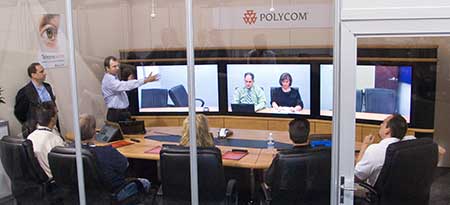 Polycom Telepresence Exhibit Digital signage has continued to gain traction beyond the traditional airport and shopping mall venues. On the surface, these TVs look very much like the HDTVs you have in your family rooms at home. But often these workhorses are engineered to withstand the rigors of rain, sun, smoke and twelve to fifteen hour days. Many vendors were showcasing weatherproof and vandal resistant enclosures, which are essential for torture-test projects like the recently announced venture between Samsung and Outdoor Promotions. The plan is to install eighteen 70" displays at prominent bus shelters on the Las Vegas strip. With millions of pawing pedestrians and exhausting cars passing by in 100+ degree heat, conditions couldn't be much harsher. To shine in variable lighting conditions, many digital signage displays are brighter - up to 1500 - 2000 nits instead of the 500 nits of a typical consumer HDTV. In parallel with the trend in traditional HDTVs, bezels on commercial displays are shrinking. When tiling multiple monitors, if the bezel is thinner, the overall effect of the display looks more uniform, less segmented. 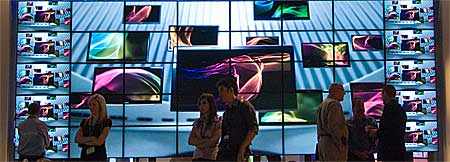 40 Screen Video Wall at the Samsung Booth Of course, when you are designing a multiple screen display or planning to coordinate monitors throughout an installation, the ability to network the units together is essential. Many of the more elaborate systems must require a dedicated IT staff. Though this year, I noticed more networking and content design applications that were geared towards the smaller installations of one to ten displays. As a boon to owners of clubs, pubs and restaurants, many vendors were providing simpler template-based software solutions for content design and delivery. With one of these systems, I could imagine that a nimble bar owner could instantly announce a drink special on TV right after the home team scored. Also facilitating the installation of smaller systems, manufacturers like Westinghouse were presenting wireless solutions, which eliminate the need for often costly and unsightly rewiring of a facility. The Westinghouse display has the wireless receiver integrated into its frame. The current capacity of the matching wireless, line-of-sight transmitter is 1080i. With Sony and many others championing their own wireless solutions, I think that we will see a similar expansion of consumer products that will allow us to connect home theater components without the need to snake wires all over the house. 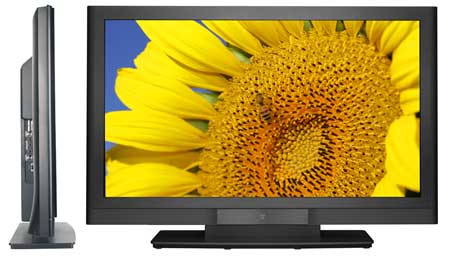 Westinghouse P4210FW Wireless HDTV One of the hindrances to a wider acceptance of digital signage by the advertising community is the lack of a method of measuring the audience. Various forms of data gathering and interactivity are addressing that issue. Perhaps the simplest is the placement of a camera near the sign to not only see who is passing by but also who is paying attention to the message. Taken a step further, I saw a system that surmised the sex of the viewers (through some unknown formula of size and hair length) standing in front of the display. Supposedly, the ad could be changed to suit the gender. Though I don't believe they yet have a metric for homosexuals or metrosexuals. Of course, when we all have RFIDs implanted in our credit cards or under our skin, then we can be scanned and a personalized message will be transmitted á la Minority Report. If you saw that Philip K. Dick inspired movie, then you may remember Tom Cruise paging through files just by running his hands over an interface. Yes, I realize you can do that on your iPhone, but to see that interactivity on a 50" monitor is still cool. It's even more impressive when the underlying content is riveting. Brian Wannamaker of Content Interface Corporation was impressing visitors at the Panasonic booth with a touchscreen presentation that included a visual representation of the ozone layer overlaid on the map of the world. By touching certain cities on the map, he zoomed in and displayed a day by day animation of that area. The educational, entertainment and advertising possibilities for this type of interactivity are enticing. On the not-quite-there front, Philips and others were featuring a 3D television that did not require glasses of any kind. With the implementation of a lenticular lens system in the TV, you could see 3D content. I looked at a number of these TVs from various distances and viewing angles and I never found a satisfactory sweet spot. I saw 3D but it didn't look as good or convincing as a display with glasses. Perhaps the coolest prototype that I saw last week was a tiny handheld device labeled a pico projector that was showing at the 3M booth at the Projection Summit, which is held before InfoComm. About the size of an iPhone, this baby projector could display an image about a foot wide at almost that distance away. The 640 x 480 pixel image is not that bright so room conditions need to be fairly dark for optimum viewing.  3M Pico Projector Light Engine We should see products using this technology emerging later this year and in 2009. Forecasts on the pico projector market were being bandied about, and applications varied from a magnifying glass to portable videoconferencing. Many believe the killer app will be the integration of the projector light engine, which is about the size of a quarter, into a handheld like an iPod. InfoComm is not a venue for consumer TVs, but I did talk to Scott Birnbaum, the VP of Samsung's LCD business. He laid out the road map for the future of that company's consumer LCD products. He said, in the near term - now that 1080p is dominating the landscape - LCDs will be differentiated by their frame rate, with 120 Hz TVs as higher end models. I don't find that the jump from 60 to 120 produces that significantly better image quality. 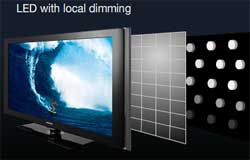
I was glad to hear him talk about LCDs using LEDs as lighting elements, and was especially excited about Samsung's implementation of LED dimming technology, which I think is a major advancement in image quality. Samsung, Sony and others are introducing LED dimming HDTVs this year and I'm looking forward to reviewing them. Birnbaum also talked about the inevitable march to TVs with resolutions beyond 1080p. Touring the InfoComm floor, you see examples of them already, with what is labeled 4K resolution, 2560 x 1600. Until entertainment content begins to be produced in 4K, I don't foresee a wide adoption in the consumer TV realm. Though they will become more prevalent as computer monitors. Not to forget plasmas, I visited a private suite where Pioneer was showing off its ninth generation plasma technology. You wouldn't think that the absence of light could generate such jaw-dropping responses, but the black levels on their Kuro line delightfully disjoint my mandible. 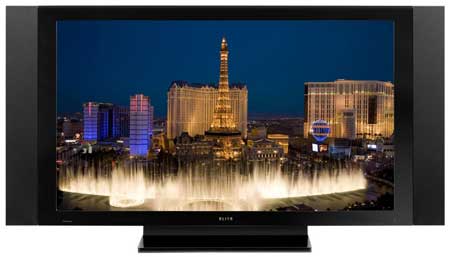 9th Generation Pioneer Plasma, Kuro PRO-111FD Finally, I could not find an OLED display anywhere. I expect to discover a few at CEDIA in September. Stay tuned. |
Bookmark:
![]() del.icio.us
del.icio.us
![]() Reddit
Reddit
![]() Google
Google
| Send this Page | Print this Page | Report Errors |

